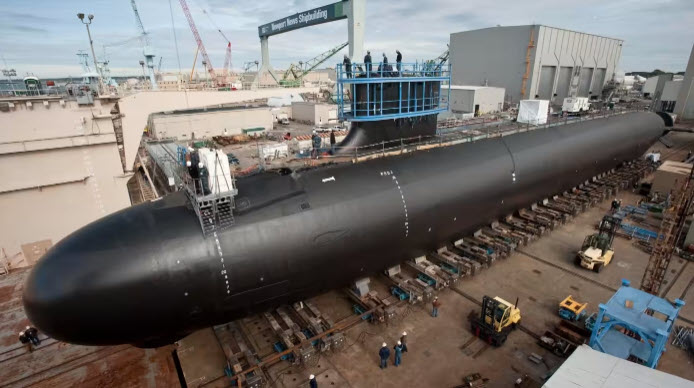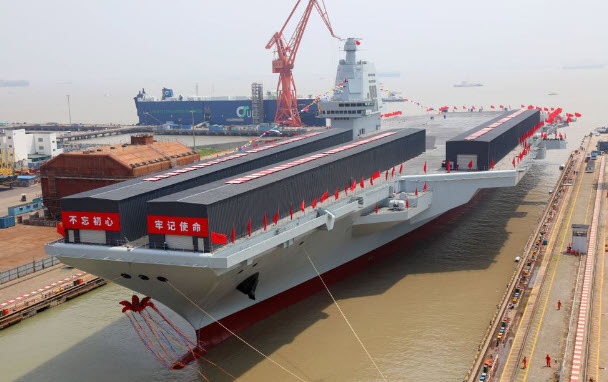
U.S. cuts key submarine order for 2025 amid shipbuilding jam
By Ken Moriyasu
12 March 2024
WASHINGTON — The U.S. Department of Defense will order just one Virginia-class nuclear-powered attack submarine in fiscal 2025, a drop from the two-per-year pace of recent years.
The decrease, announced Monday, reflects U.S. shipbuilding bottlenecks. The two private shipyards that produce the Virginia class — General Dynamics and Huntington Ingalls Industries — face mounting backlogs due to limited capacity and personnel shortages.
The decision also highlights the Pentagon’s dilemma of having to counter a massive defense buildup by China while under fiscal limitations. The Pentagon’s total fiscal 2025 budget request was $849.8 billion, a 0.9% increase on the year. China’s annual defense budget for 2024, revealed earlier this month, grew by 7.2% to 1.67 trillion yuan ($233 billion).
The growth of the American defense budget was constrained by the Fiscal Responsibility Act, a debt-limit deal struck in mid-2023 that capped the budget to a 1% increase from the fiscal 2024 request. Taking inflation into account, the Pentagon, in effect, had to cut roughly $10 billion from last year’s plan.
The costly Virginia class was among the casualties; funding for the program came in at $8.2 billion, a 24% drop from fiscal 2024.
The delay of the Virginia class exposes the strains of the AUKUS defense pact as well. Together with the U.K., the arrangement seeks to provide Australia with nuclear-powered submarines. The U.S. has promised to sell Australia three Virginia-class submarines, in 2032, 2035 and 2038, with the option of providing two more. The idea is to strengthen deterrence in the Indo-Pacific region with key allies, but Navy officials have raised concerns about the impact AUKUS will have on shipyards.
The two-boats-per-year pace only addressed U.S. demand. To cater to AUKUS, the U.S. needs to construct 2.33 submarines per year, according to the Congressional Research Service. The actual delivery rate has averaged 1.2 boats per year for the past five years.
The budget request included $4 billion in investments in the submarine industrial base, which the Pentagon described as “a historic investment in supplier and workforce development as well as infrastructure expansion and technological advances.”
The Navy’s decision to cut procurement of the Virginia class drew immediate backlash from Congress. Rep. Joe Courtney, a Democrat from Connecticut and the ranking member of the House seapower and projection forces subcommittee, issued a statement on Monday saying the course correction “makes little or no sense.”
“If such a cut is actually enacted, it will remove one more attack submarine from a fleet that is already 17 submarines below the Navy’s long stated requirement of 66,” Courtney said. “Given the new commitment the Department of Defense and Congress made last year to sell three submarines to our ally Australia, which I enthusiastically support, the ramifications of the Navy’s proposal will have a profound impact on both countries’ navies.”
The ax also fell on the F-35 fighter jet. Procurement is set to drop to 68 aircraft in 2025, from 83 in 2024. Funding for the F-35 program was $12.4 billion, an 8.5% decrease from the year before.
Meanwhile, the defense budget prioritized funding for the sea-, land-, and air-based nuclear triad. This comes in the context of China’s growing nuclear arsenal. The Pentagon estimates that China will have over 1,000 operational nuclear warheads by 2030.
The budget includes $49.2 billion for the modernization of nuclear forces, a 31% increase from 2024, including “full funding” of $9.9 billion for the Columbia-class ballistic missile submarine, $3.7 billion for the future land-based intercontinental ballistic missile Sentinel and $5.3 billion for the development and procurement of the B-21 strategic bomber.
For the first time, the Pentagon requested funding related to Taiwan in the form of drawdown authority, an executive power that allows supplies to be sent to foreign partners. The funding would enable the department to replenish its inventory of munitions and equipment that have been transferred to Taiwan.


